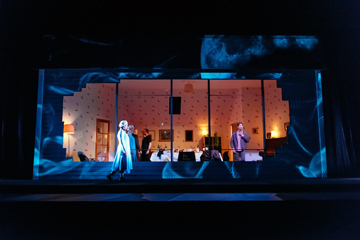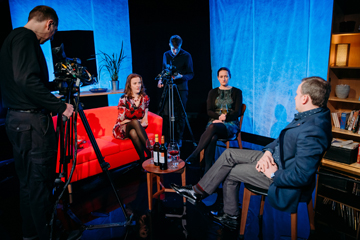Theatre: Vanishing Point Plays
By Justine Bayod Espoz
January 15, 2017
 Interiors |
During its 2016 edition, the Edinburgh International Festival bestowed Scotland's own Vanishing Point theater company with the honor of presenting two of its productions: the company’s most recent project The Destroyed Room and a restaging of 2009’s Interiors. Upon watching both works, it becomes abundantly clear that the pairing is meant to explore the relationship between participant and spectator, cleverly playing with the concept of the fourth wall in order to manipulate the viewer’s experience.
The aptly titled Interiors places the audience in front of two large windows that reveal the interior of a house. It is through these windows that we watch a small party unfold, the glass obstructing our ability to hear the conversations taking place inside. At first, the audience is reduced to a simple visual voyeur left to its own creative devices when piecing together a complete story. That is, of course, until a ghost appears to narrate some, but not all, of the party-goers’ private thoughts.
The production’s narrative thread is limited simply to the course of a more or less average evening amongst friends. The focus is on the individuals rather than the group as a whole, a tactic designed to draw you from the already private space inside a home into the even more private space of the character’s minds. The success of this theatrical gambit is entirely predicated on how emotionally or intellectually invested the audience becomes in the characters, and unfortunately for Vanishing Point, these characters don’t generate much investment.
Interiors bore a striking similarity to spending a night chit chatting with friends of friends at a low-key get-together, but at least in real life you can participate in the small talk rather than just listening to it listlessly. Even a potentially intriguing new conceptualization of the role of the observer falls flat when proper character development and storytelling are not fully realized.
 The Destroyed Room |
In the second Vanishing Point production, The Destroyed Room, Jeff Wall's 1978 photograph of the same name serves as the premise for a conversation amongst three actors. The image is of a ransacked room that leaves the viewer to ponder what happened moments before the picture was snapped. What caused such destruction and why?
The audience is deceptively told by one of two cameramen filming the discussion that what we are about to see is an entirely unplanned and unscripted event; that a different yet photo-related question kicks off the nightly round of discourse so that a distinct discussion takes place each night. Some audience members may, at this point, silently question when a discussion amongst actors began to pass for theatre.
Thankfully, this is not the actual case. Although there is some witty, off-the-cuff banter early on, the conversation quickly, and just a little too obviously, switches over to a scripted conversation that addresses how Westerners observe from afar the horrors of war and natural disasters half a world away. The play asks the uncomfortable question of how we know when we've crossed the line from concerned observer to accessorial voyeur. When does a desire to be informed become straightforward morbid curiosity? And what kind of social fallout does that shift generate?
Unlike Interiors, which imposes a physical fourth wall to make us examine our supposed desire to get around it, The Destroyed Room removes the theatrical fourth wall in order to show us that our TV and computer screens are the new fourth wall, creating a safe barrier from which we watch the rest of humanity without actively participating. It is a thought-provoking piece that, hopefully, has us questioning our own motives each time we choose to look at video or photographs of the death and anguish of others. It’s an extremely timely piece that should be seen far and wide regardless of how uncomfortable its themes might make us.
